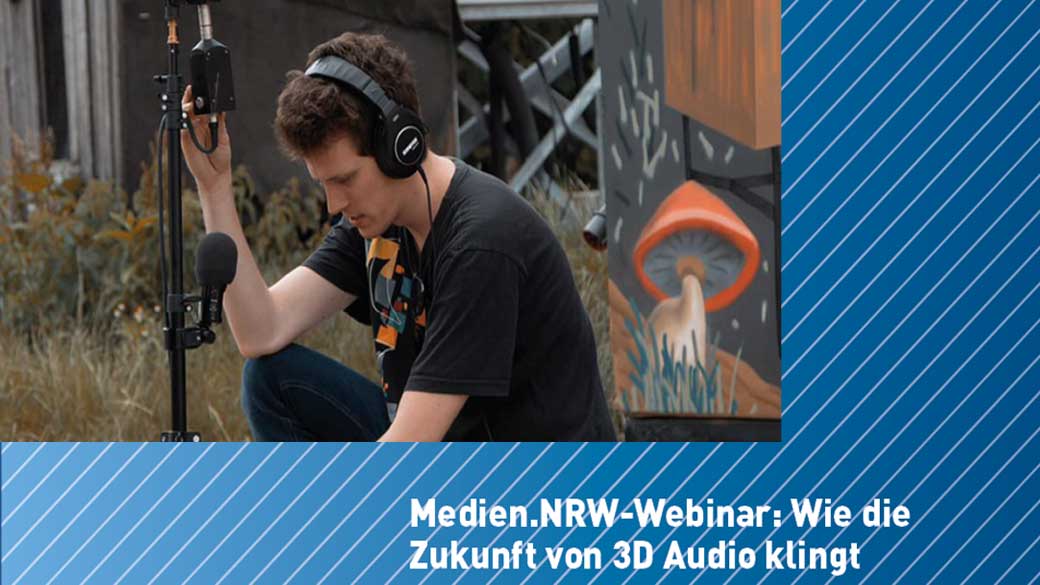
Medien.NRW Webinar 3D Spatial Audio with Martin Rieger
The fact that 3D audio in VR makes a decisive difference is already on most people’s radar. But what exactly is this spatial sound or whatever you want to call the new listening experience?
This is exactly what will be demonstrated with practical examples in the upcoming Medien.NRW webinar on 3D Audio on 26 November at 11:00 am. State-of-the-art audio technology meets creativity and unfolds its true potential. What does it sound like? Headphones on!
Martin Rieger (VRTonung) is a sound engineer who specialises like no other in the German-speaking world in the dubbing of immersive media. He wants to show what the added value of spatial hearing actually is and looks behind the Spatial Audio buzzwords of Apple, Dolby and Co.
Friday, 26 November 2021 | 11.00 – 13.00 | Online
Register for free in the Medien NRW App to take part in the stream.

Inquired by…Martin Rieger, VRTONUNG
Most people first think of XR as a visual experience. But XR experiences only become truly realistic with the right sound. And that’s exactly what Martin Rieger provides, because he specialises in 3D audio. That means he adds spatial sound to immersive projects. His goal is not just to scratch the surface, but to exploit the full potential of so-called “spatial sound” and create thrilling audio experiences.
Mediennetzwerk.NRW: Dear Martin, you set immersive projects to music. Now you’re a guest at our webinar on 3D audio.
Could you briefly explain what immersive media or immersive audio is all about?
“Immersion” has become quite a buzzword. In the audio world, the term refers to the third dimension of sound reproduction. Mono (0D), stereo (1D), surround (2D) and now immersive audio (3D). So the sound comes not only from the left or the right, but from all conceivable directions.
But enough about the technology, for me it ultimately means that audio content is also conceptually thought out in stereo. The users become much more part of an experience. This can be in VR, a loudspeaker installation in the room, but also via a simple pair of headphones. Immersive media such as XR are usually better suited for immersive audio than classic media such as TV and radio and simply offer more scope to stage the sound freely.
People also like to talk about creating an “enveloping” audio experience that feels as natural as reality. This makes it easier for our brain to process the impressions and the immersion in virtual worlds is demonstrably improved.
In which areas does 3D audio already play a role and where could it offer added value in the future?
Currently, the topic is being driven forward primarily by Dolby Atmos Music and Sony 360 Reality Audio. Ever since Apple jumped on the bandwagon and integrated millions of “spatial audio” into hardware and software, 3D audio has become mainstream. This means that the focus is currently on typical consumer applications such as music and films, which sound even more beautiful with 3D audio than stereo or surround. Many overlook the true potential of immersive audio, and apart from the teething troubles, the marketing can also be very confusing.
In VR, however, we don’t even need to argue about whether 3D is really better than stereo because, among other things, we can intuitively direct the user’s gaze. We can’t see what’s happening behind us, but we can make audio audible with 3D. But applications in the field of communication are also becoming more and more popular, thus naturally solving the problem of zoom fatigue. 3D audio sounds very niche, but if you go down the rabbit hole, you’ll find a huge game-changer.
Du sagst, dass Begriffe wie “Spatial Sounds” oder 3D Audio häufig genutzt werden um innovativ zu klingen, aber selten das eigentliche Potential der Technologie ausgeschöpft wird.
How do you get the best out of the technology in your projects?
I am currently experimenting a lot in different areas. From online marketing for tourism, to consulting in the automotive industry, to art installations in German museums, for example.
Thanks to over 50 immersive projects, from VR to AR to headphone applications, I’ve been able to develop a few formulas for 3D audio that I know always work well. So whether it’s that the spatial sound supports the storytelling or that the listener has a wow experience by making him or her forget that he or she is wearing headphones at all with the right sound design.
The trick is not to compulsively dub any project in 3D in order to put a stamp on it. Films, for example, are more fun in 3D – but the story also works well in stereo. That’s why I specifically look for immersive applications where I know in advance that the sound will have a strong added value. In other words, I turn the tables, put sound at the top of the priority list and don’t have to make any compromises from conception to production.
More 3D Audio Insights